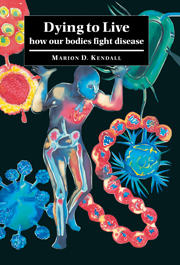8 - Survival of the Fittest
Published online by Cambridge University Press: 29 September 2009
Summary
Alopecia areata It is said that the hair of Marie Antoinette turned white over-night before her execution in the French Revolution. How could this happen? Similar, but usually slower, changes occur in people who suffer alopecia areata or hair loss diseases. These are different from the hair loss described as male pattern baldness which is a normal part of ageing in men. In many cases of alopecia areata, the onset of disease follows illness or extreme stress. The exact cause of hair loss is not known, although recently it has been demonstrated that autoantibodies are present in disease sufferers, suggesting that the body is for some reason reacting against its own hair follicles and causing them to thin at the roots to form what are called ‘exclamation mark’ hairs. These weakened hairs fall out, or can be brushed out easily. Since it is always the pigmented hairs that are attacked, the white hairs of the head are left. The patient appears to turn grey rapidly, but actually the greying hairs were there all the time, but masked by the coloured hairs. In addition any hairs that regrow may now be white instead of the original colour.
Alopecia can appear in both men and women, at any age and over any hair-bearing site. There are several forms of the condition. The most common and mild is patchy alopecia. The hair may fall out or be brushed out in small patches on the scalp, and regrow again later.
- Type
- Chapter
- Information
- Dying to LiveHow our Bodies Fight Disease, pp. 126 - 145Publisher: Cambridge University PressPrint publication year: 1998



